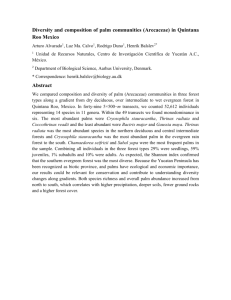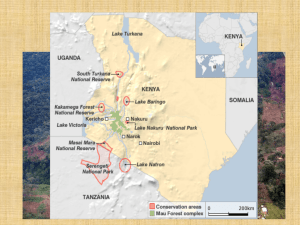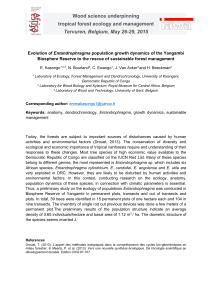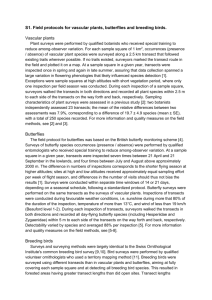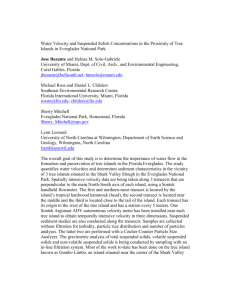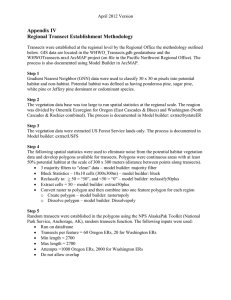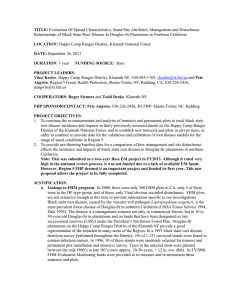Supplement
advertisement
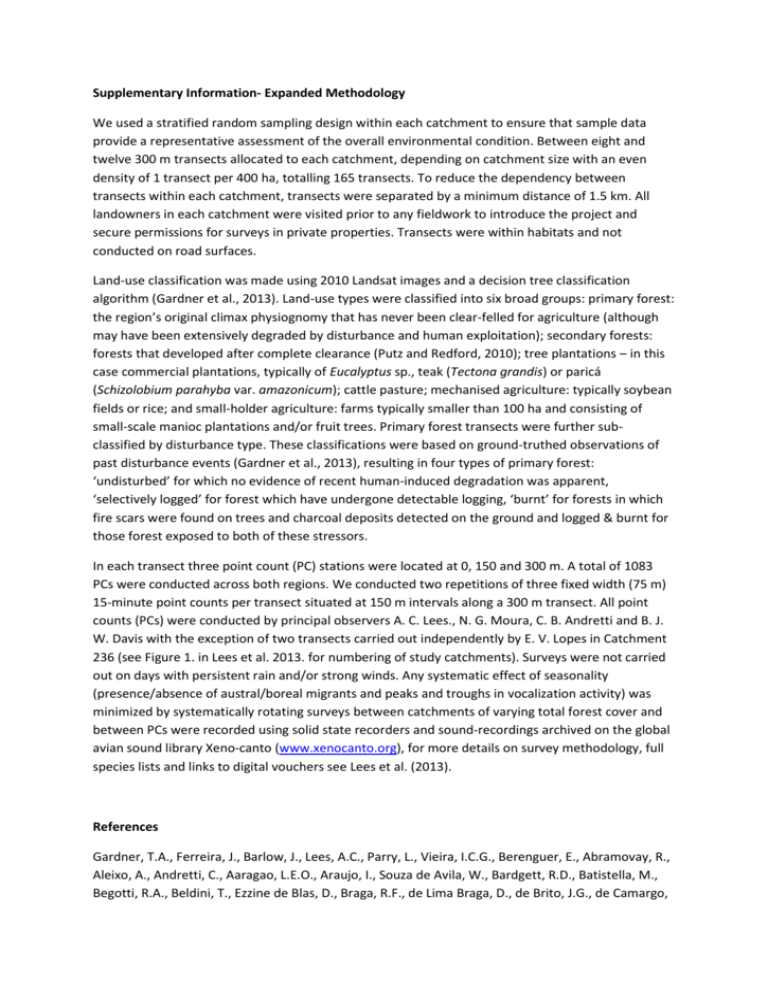
Supplementary Information- Expanded Methodology We used a stratified random sampling design within each catchment to ensure that sample data provide a representative assessment of the overall environmental condition. Between eight and twelve 300 m transects allocated to each catchment, depending on catchment size with an even density of 1 transect per 400 ha, totalling 165 transects. To reduce the dependency between transects within each catchment, transects were separated by a minimum distance of 1.5 km. All landowners in each catchment were visited prior to any fieldwork to introduce the project and secure permissions for surveys in private properties. Transects were within habitats and not conducted on road surfaces. Land-use classification was made using 2010 Landsat images and a decision tree classification algorithm (Gardner et al., 2013). Land-use types were classified into six broad groups: primary forest: the region’s original climax physiognomy that has never been clear-felled for agriculture (although may have been extensively degraded by disturbance and human exploitation); secondary forests: forests that developed after complete clearance (Putz and Redford, 2010); tree plantations – in this case commercial plantations, typically of Eucalyptus sp., teak (Tectona grandis) or paricá (Schizolobium parahyba var. amazonicum); cattle pasture; mechanised agriculture: typically soybean fields or rice; and small-holder agriculture: farms typically smaller than 100 ha and consisting of small-scale manioc plantations and/or fruit trees. Primary forest transects were further subclassified by disturbance type. These classifications were based on ground-truthed observations of past disturbance events (Gardner et al., 2013), resulting in four types of primary forest: ‘undisturbed’ for which no evidence of recent human-induced degradation was apparent, ‘selectively logged’ for forest which have undergone detectable logging, ‘burnt’ for forests in which fire scars were found on trees and charcoal deposits detected on the ground and logged & burnt for those forest exposed to both of these stressors. In each transect three point count (PC) stations were located at 0, 150 and 300 m. A total of 1083 PCs were conducted across both regions. We conducted two repetitions of three fixed width (75 m) 15-minute point counts per transect situated at 150 m intervals along a 300 m transect. All point counts (PCs) were conducted by principal observers A. C. Lees., N. G. Moura, C. B. Andretti and B. J. W. Davis with the exception of two transects carried out independently by E. V. Lopes in Catchment 236 (see Figure 1. in Lees et al. 2013. for numbering of study catchments). Surveys were not carried out on days with persistent rain and/or strong winds. Any systematic effect of seasonality (presence/absence of austral/boreal migrants and peaks and troughs in vocalization activity) was minimized by systematically rotating surveys between catchments of varying total forest cover and between PCs were recorded using solid state recorders and sound-recordings archived on the global avian sound library Xeno-canto (www.xenocanto.org), for more details on survey methodology, full species lists and links to digital vouchers see Lees et al. (2013). References Gardner, T.A., Ferreira, J., Barlow, J., Lees, A.C., Parry, L., Vieira, I.C.G., Berenguer, E., Abramovay, R., Aleixo, A., Andretti, C., Aaragao, L.E.O., Araujo, I., Souza de Avila, W., Bardgett, R.D., Batistella, M., Begotti, R.A., Beldini, T., Ezzine de Blas, D., Braga, R.F., de Lima Braga, D., de Brito, J.G., de Camargo, P.B., Campos dos Santos, F., Campos de Oliveira, V., Cordeiro, A.C.N., Cardoso, T.M., de Carvalho, D.R., Castelani, S.A., Chaul, J.C.M., Cerri, C.E., De Assis Costa, F., da Costa, C.D.F., Coudel, E., Coutinho, A.C., Cunha, D., D’Antona, A., Dezincourt, J., Dias-Silva, K., Durigan, M., Esquerdo, J.C.D., Feres, J., de Barros Ferraz, S.F., de Melo Ferreira, A.E., Fiorini, A.C., da Silva, L.V.F., Frazao, F.S., Garrett, R., dos Santos Gomes, A., da Silva Goncalves, K., Guerrero, J.B., Hamada, N., Hughes, R.M., Igliori, D.C., da Conceição Jesus, E., Juen, L., Junior, M., de Oliveira Junior, J.M.B., de Oliveira Junior, R.C., Junior, C.S., Kaufmann, P., Korasaki, V., Leal, C.G., Leitao, R., Lima, N., de Fatima Lopes Almeida, M., Lourival, R., Louzada, J., Mac Nally, R.C., Marchand, S., Maues, M.M., Moreira, F.M.S., Morsello, C., Moura, N., Nessimian, J., Nunes, S., Oliveira, V.H.F., Pardini, R., Pereira, H.C., Pompeu, P.S., Ribas, C.R., Rossetti, F., Schmidt, F.A., da Silva, R., da Silva, R.C.V., da Silva, T.F.M., Silveira, J., Siqueira, J.V., de Carvalho, T.S., Solar, R.R.C., Tancredi, N.S.H., Thomson, J.R., Torres, P.C., Vaz-de-Mello, F.Z., Veiga, R.C.S., Venturieri, A., Viana, C., Weinhold, D., Zanetta, R., Zuanon, J., 2013. A social and ecological assessment of tropical land uses at multiple scales: the Sustainable Amazon Network. Phil. Trans. R. Soc. B 368 (1619), 20120166. Lees, A.C., Moura, N.G., Andretti, C.B., Davis, B.J.W., Lopes, E.V., Henriques, L.M.P., Aleixo, A., Barlow, J., Ferreira, J. & Gardner, T.A. 2013. One hundred and thirty-five years of avifaunal surveys around Santarém, central Brazilian Amazon. Revista Brasileira de Ornitologia, 21, 16-57. Putz, F.E., Redford, K.H., 2010. The importance of defining ‘forest’: tropical forest degradation, deforestation, long-term phase shifts, and further transitions. Biotropica 42, 10–20. Figure 1 ESM FIGURE 1, Variance partitioning indicates that roadless volume (RV) has 15% more explanatory power than percentage forest cover (%FC) alone, i.e. the variance explained by RV (34) minus variance explained by FC (19). Combining the two variables explains over 91% of variation in species richness, with a residual (R) of just 9%.
